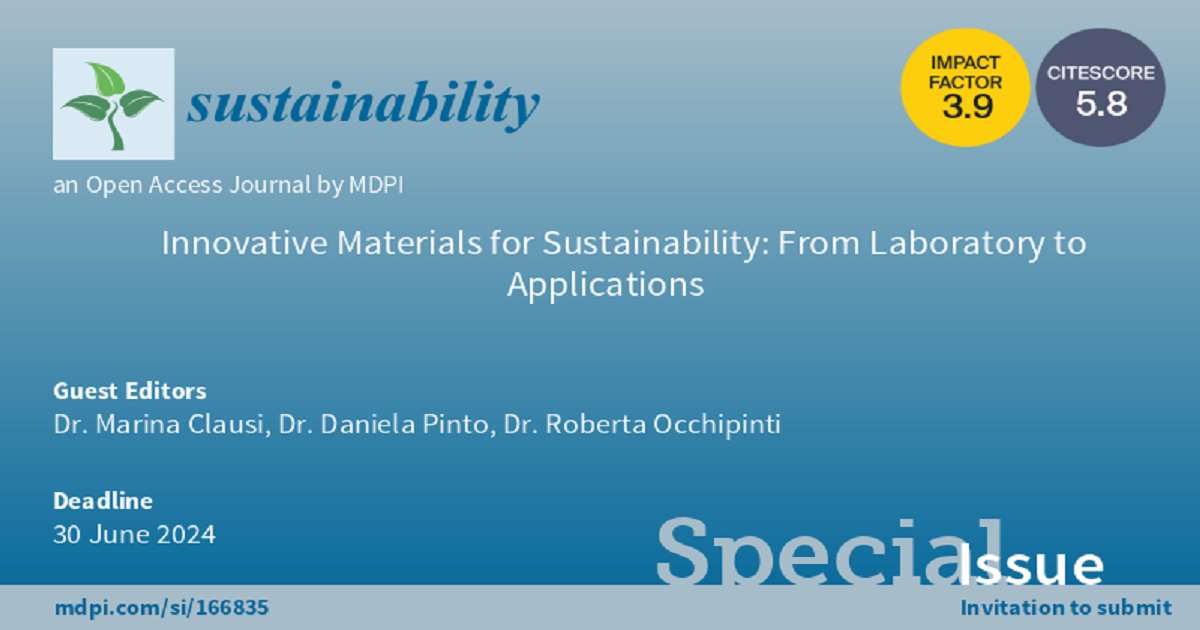Innovative Materials for Sustainability: From Laboratory to Applications
A special issue of Sustainability (ISSN 2071-1050). This special issue belongs to the section "Sustainable Materials".
Deadline for manuscript submissions: 30 June 2024 | Viewed by 8062

Special Issue Editors
Interests: applied mineralogy; artificial geo-materials; low-carbon binders; geopolymers; waste recovery; spectroscopy; chemical—physical characterizations
Interests: applied mineralogy; crystallography; artificial materials (ceramics, mortars, plasters, pigments, geopolymers); clays; X-ray diffraction
Special Issues, Collections and Topics in MDPI journals
Interests: geroresources; applied mineralogy and petrography; alkali-activated materials; recycling waste materials; eco-friendly materials; circular economy
Special Issue Information
Dear Colleagues,
In recent years, an interest growth for the production of innovative and sustainable materials, designed for a host range of applications (i.e., structural and non-structural building materials, environmental governance), has been observed. The design of these material have to meet the challenge of the environmental footprint reduction through more sustainable technological processes, such as the alkali activation process, as well as the energy and virgin materials consumption reduction and waste generation, as required by the sustainable development goals (SDGs).In this context, becomes likewise essential re-thinking the waste values shifting the production line from linear to circular.
The purpose of the Special Issue "Innovative Materials for Sustainability: From Laboratory to Applications" is to provide a deeper knowledge in the field of sustainable materials in a perspective of circular economy, focusing on the actual opportunities of technology transfer from laboratory to real applications. The issue is addressed to scientists and specialists from different disciplines, interested (but not limited to) in the following topics:
- Design and development of sustainable and innovative materials;
- Alkali activated materials/geopolymers;
- Waste management and valorisation;
- Safeguard of no-renewable resources;
- Environmental governance;
- Building materials;
- Technology transfer;
- Innovative applications.
We look forward to receiving your contributions.
Dr. Marina Clausi
Dr. Daniela Pinto
Dr. Roberta Occhipinti
Guest Editors
Manuscript Submission Information
Manuscripts should be submitted online at www.mdpi.com by registering and logging in to this website. Once you are registered, click here to go to the submission form. Manuscripts can be submitted until the deadline. All submissions that pass pre-check are peer-reviewed. Accepted papers will be published continuously in the journal (as soon as accepted) and will be listed together on the special issue website. Research articles, review articles as well as short communications are invited. For planned papers, a title and short abstract (about 100 words) can be sent to the Editorial Office for announcement on this website.
Submitted manuscripts should not have been published previously, nor be under consideration for publication elsewhere (except conference proceedings papers). All manuscripts are thoroughly refereed through a single-blind peer-review process. A guide for authors and other relevant information for submission of manuscripts is available on the Instructions for Authors page. Sustainability is an international peer-reviewed open access semimonthly journal published by MDPI.
Please visit the Instructions for Authors page before submitting a manuscript. The Article Processing Charge (APC) for publication in this open access journal is 2400 CHF (Swiss Francs). Submitted papers should be well formatted and use good English. Authors may use MDPI's English editing service prior to publication or during author revisions.
Keywords
- innovative materials
- sustainable manufacturing
- green technologies
- renewable resources
- energy safeguard
- geopolymers
- alkaline activation
- waste
- building materials
- technology transfer







